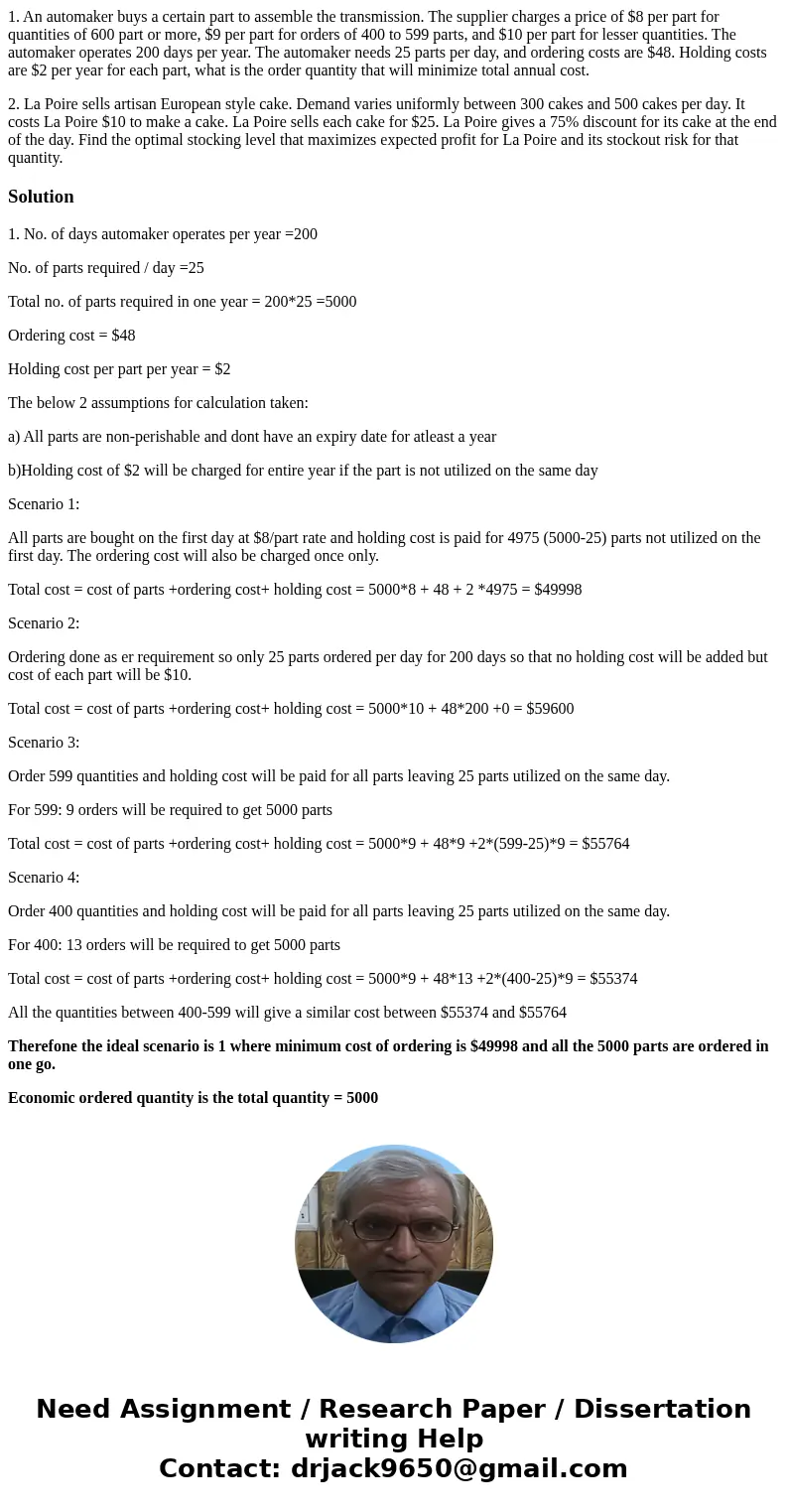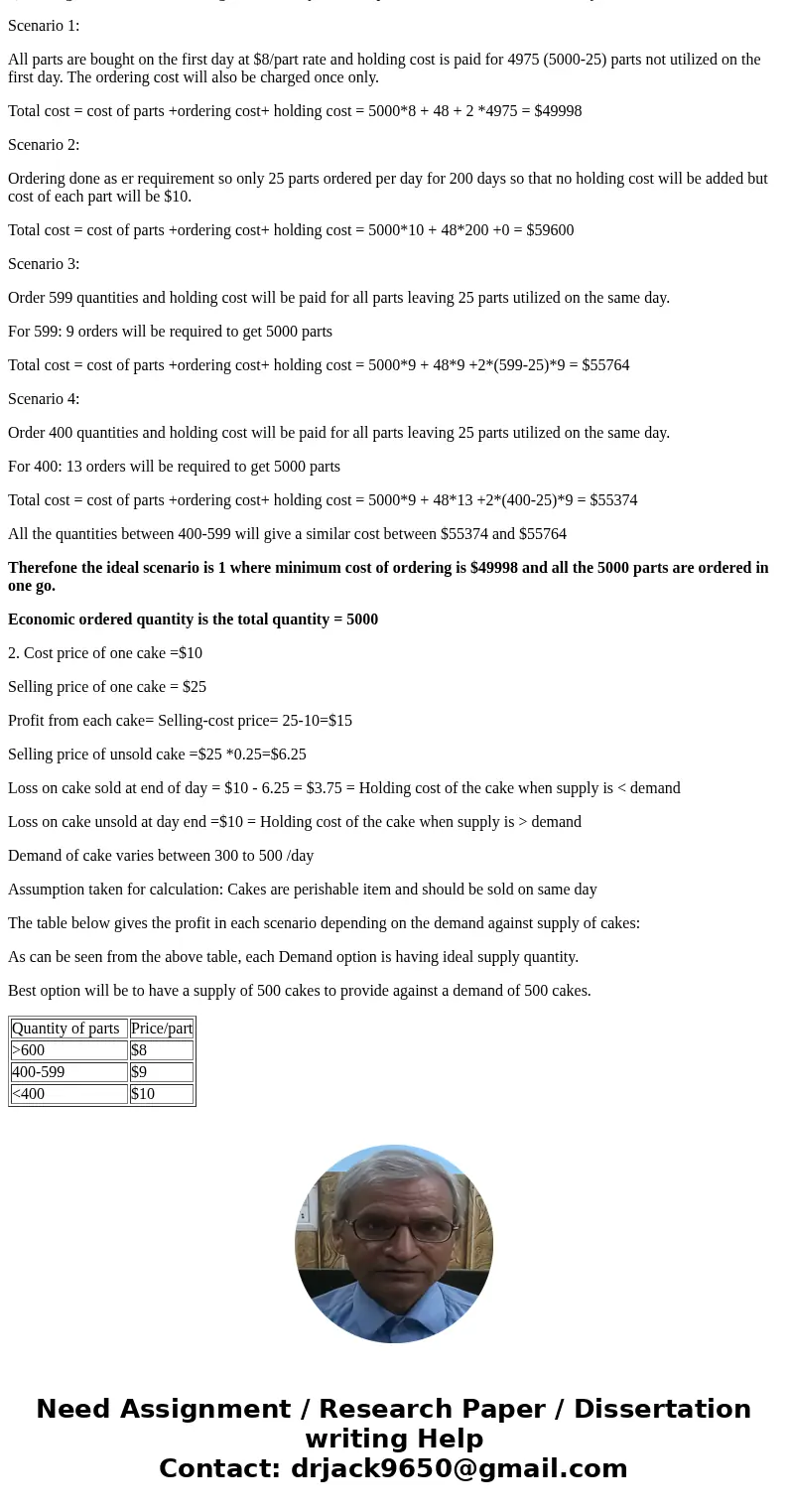1 An automaker buys a certain part to assemble the transmiss
1. An automaker buys a certain part to assemble the transmission. The supplier charges a price of $8 per part for quantities of 600 part or more, $9 per part for orders of 400 to 599 parts, and $10 per part for lesser quantities. The automaker operates 200 days per year. The automaker needs 25 parts per day, and ordering costs are $48. Holding costs are $2 per year for each part, what is the order quantity that will minimize total annual cost.
2. La Poire sells artisan European style cake. Demand varies uniformly between 300 cakes and 500 cakes per day. It costs La Poire $10 to make a cake. La Poire sells each cake for $25. La Poire gives a 75% discount for its cake at the end of the day. Find the optimal stocking level that maximizes expected profit for La Poire and its stockout risk for that quantity.
Solution
1. No. of days automaker operates per year =200
No. of parts required / day =25
Total no. of parts required in one year = 200*25 =5000
Ordering cost = $48
Holding cost per part per year = $2
The below 2 assumptions for calculation taken:
a) All parts are non-perishable and dont have an expiry date for atleast a year
b)Holding cost of $2 will be charged for entire year if the part is not utilized on the same day
Scenario 1:
All parts are bought on the first day at $8/part rate and holding cost is paid for 4975 (5000-25) parts not utilized on the first day. The ordering cost will also be charged once only.
Total cost = cost of parts +ordering cost+ holding cost = 5000*8 + 48 + 2 *4975 = $49998
Scenario 2:
Ordering done as er requirement so only 25 parts ordered per day for 200 days so that no holding cost will be added but cost of each part will be $10.
Total cost = cost of parts +ordering cost+ holding cost = 5000*10 + 48*200 +0 = $59600
Scenario 3:
Order 599 quantities and holding cost will be paid for all parts leaving 25 parts utilized on the same day.
For 599: 9 orders will be required to get 5000 parts
Total cost = cost of parts +ordering cost+ holding cost = 5000*9 + 48*9 +2*(599-25)*9 = $55764
Scenario 4:
Order 400 quantities and holding cost will be paid for all parts leaving 25 parts utilized on the same day.
For 400: 13 orders will be required to get 5000 parts
Total cost = cost of parts +ordering cost+ holding cost = 5000*9 + 48*13 +2*(400-25)*9 = $55374
All the quantities between 400-599 will give a similar cost between $55374 and $55764
Therefone the ideal scenario is 1 where minimum cost of ordering is $49998 and all the 5000 parts are ordered in one go.
Economic ordered quantity is the total quantity = 5000
2. Cost price of one cake =$10
Selling price of one cake = $25
Profit from each cake= Selling-cost price= 25-10=$15
Selling price of unsold cake =$25 *0.25=$6.25
Loss on cake sold at end of day = $10 - 6.25 = $3.75 = Holding cost of the cake when supply is < demand
Loss on cake unsold at day end =$10 = Holding cost of the cake when supply is > demand
Demand of cake varies between 300 to 500 /day
Assumption taken for calculation: Cakes are perishable item and should be sold on same day
The table below gives the profit in each scenario depending on the demand against supply of cakes:
As can be seen from the above table, each Demand option is having ideal supply quantity.
Best option will be to have a supply of 500 cakes to provide against a demand of 500 cakes.
| Quantity of parts | Price/part |
| >600 | $8 |
| 400-599 | $9 |
| <400 | $10 |


 Homework Sourse
Homework Sourse